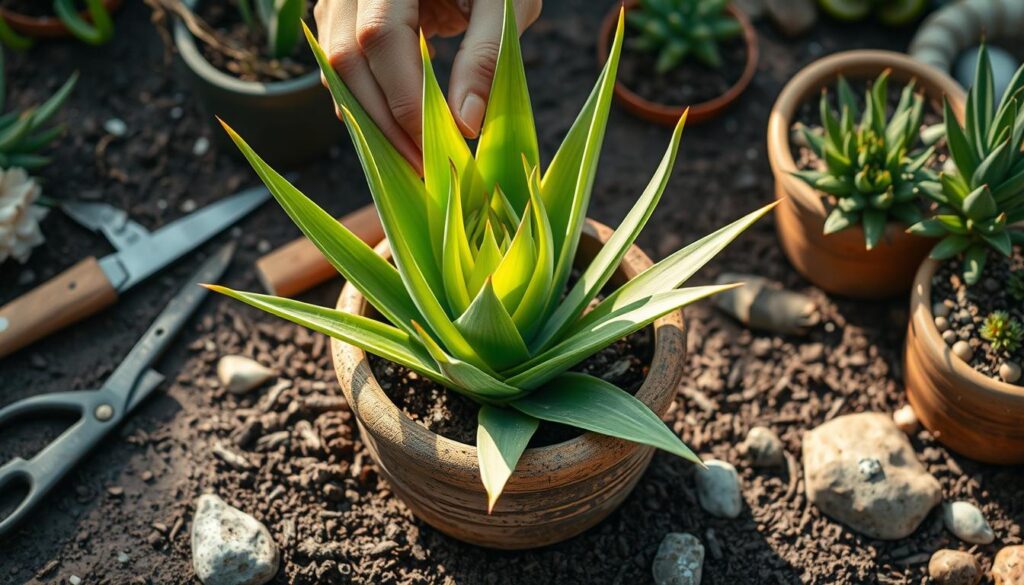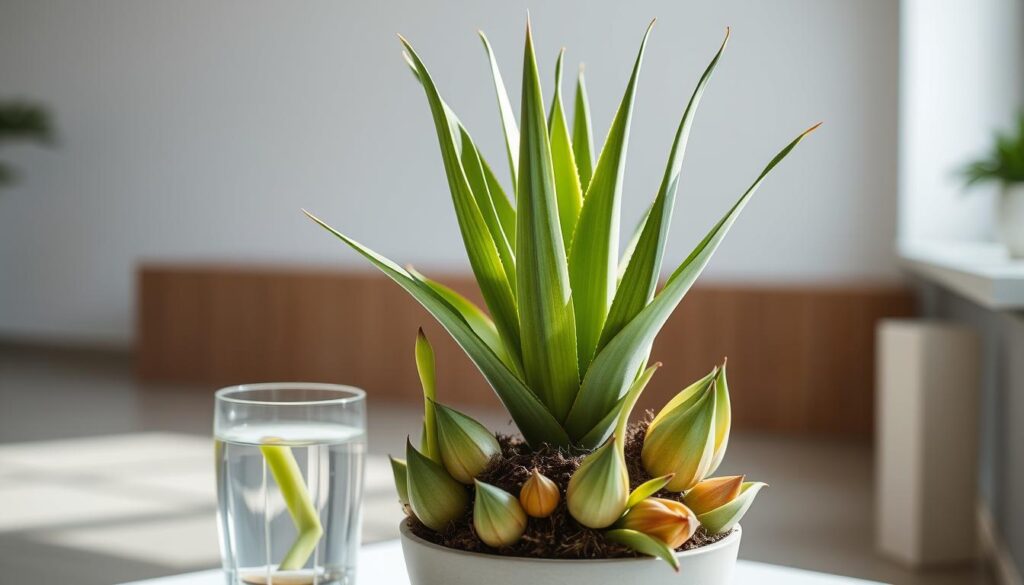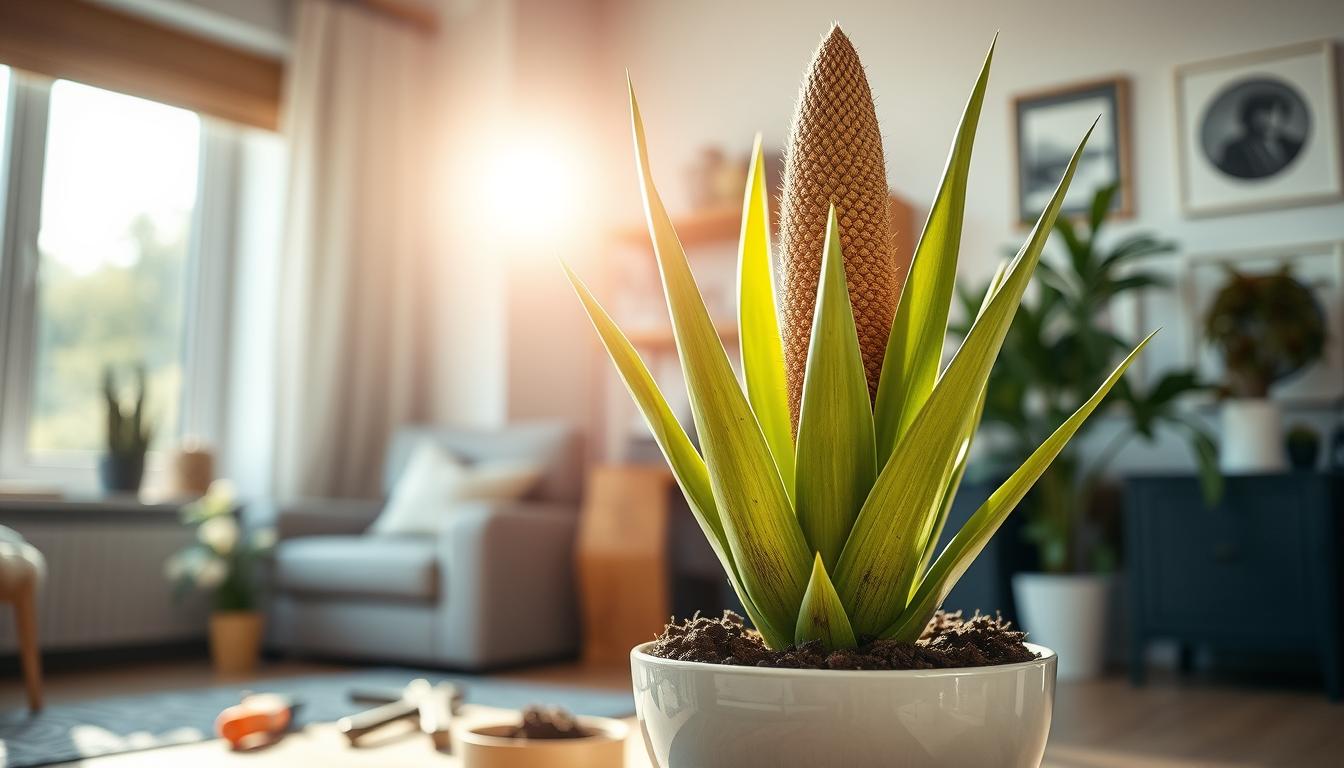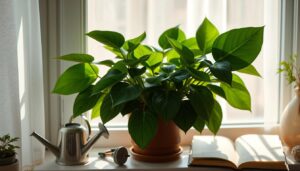Yucca plants are special because they can grow well indoors with little care. They come in over 50 different types, each with its own look. If you’re thinking about getting a yucca plant, you might wonder how to take care of it.
Yucca plants are great at cleaning the air and can handle very hot or cold temperatures. They make any room better. By knowing what your yucca plant needs, you can help it grow strong and beautiful.
Introduction to Yucca Plants
Thinking about getting a new plant? Yucca plants are a great pick. They look amazing and are easy to care for. With over 40 types, they’re perfect for indoor gardens.
Yucca plants come from dry places in North and Central America. They love dry air, which is good for forgetful waterers.
Yucca plants clean the air and make your home look better. They’ve been used for medicine by Native Americans. With the right care, they can live up to 5 years indoors and 20-50 years outside.
What Makes Yucca Plants Unique?
Yucca plants stand out with their long, sharp leaves and tall stalks. They can handle cold and don’t need much water. Some can grow up to 30 feet tall, adding drama to any room.
Benefits of Growing Yucca Indoors
Yucca plants are good for indoor air and easy to care for. They bring desert beauty to your home. With the right care, they do well indoors, making them a favorite houseplant.
Learning about Yucca plants helps you decide if they’re for you. They’re beautiful and easy to care for. Yucca plants are a great choice for adding beauty and freshness to your home.
Ideal Growing Conditions for Yucca
To grow a thriving Yucca Plant, it’s key to mimic its natural home indoors. This means giving it the right light, temperature, and humidity. Yucca plants love bright, indirect light. They can grow up to 3-5 meters tall, needing a temperature of 65 to 75 degrees Fahrenheit.
When setting up the best spot for your Yucca, remember a few things:
* Give it bright, indirect light.
* Keep the temperature steady between 65 to 75 degrees Fahrenheit.
* Make sure the humidity is low to moderate.
* Use soil that drains well to avoid root rot.
By knowing and meeting the Yucca Plant’s light and temperature needs, you can make a perfect home for it. Adjust these conditions based on your space and your plant’s specific needs.
| Factor | Ideal Condition |
|---|---|
| Light | Bright, indirect light |
| Temperature | 65 to 75 degrees Fahrenheit |
| Humidity | Low to moderate |
Watering Your Yucca Plant
Watering your Yucca Plant right is key. They like a little water, not too much. Water them every couple of weeks in spring and summer. Too much water hurts them, too little makes them stressed.
To see if they need water, check the soil. Stick your finger in it up to your knuckle. If it’s dry, it’s time to water.
Watch out for signs of too much water. Yellow leaves, dropped leaves, and soft stems mean trouble. If you see these, stop watering and let the soil dry out. Learn more about overwatering and saving your plants to keep your Yucca Plant healthy.
How Often Should You Water?
How often you water depends on the season and soil dryness. Water every 10-14 days in spring and summer. In fall and winter, water every 4-6 weeks. Remember, humidity and temperature affect how dry the soil gets.
Signs of Overwatering
Look out for yellowing leaves, leaf drop, and mushy stems. These are signs of too much water. If you see these, act fast to save your plant. Pay attention to your Yucca Plant’s needs and watch for these signs to keep it healthy.
Soil and Potting Recommendations
Choosing the right soil and pot for your Yucca Plant is key. Yucca plants love dry, sandy soil. They do best in poor, dry, and alkaline soil, not rich soil.
A good Yucca Plant soil mix drains well to avoid root rot. You can make your own mix. Use 4 parts peat-based potting mix, 5 parts perlite, and 1 part coarse sand.
Another mix option is equal parts horticultural sand, perlite or lava gravel, and leaf mold or compost. Pick a pot that’s a bit bigger than the plant’s roots. This helps avoid too much water.
Yucca plants like a steady indoor temperature. They do well in warm, dry places with good air flow. A quality soil mix and the right pot keep your Yucca Plant happy and healthy.

Key Characteristics of a Good Yucca Plant Soil Mix
- Well-draining to prevent waterlogged soil
- Poor, dry, and alkaline soil pH
- High perlite or sand content for improved drainage
- Avoid rich, fertile soil that can retain too much water
Follow these tips for a great Yucca Plant soil mix. Repot your Yucca plant every few years. Use a pot that’s just a bit bigger than the root ball. With the right soil and pot, your Yucca Plant will thrive.
Fertilization Techniques
Yucca Plants need nutrients to grow well. Use Yucca Plant fertilizers from spring to fall. A balanced fertilizer, like 2-1-2 or 3-1-2 NPK ratio, helps a lot.
Choose fertilizers made for cacti and succulents. They have less nitrogen to protect the roots. Organic options like compost or manure also work well.
When to Fertilize
Young Yucca plants need diluted fertilizer every 4 to 6 weeks. Older plants get full-strength fertilizer every 6-8 weeks in spring and summer. Stop fertilizing in winter.
Types of Fertilizers for Yucca
Here are some good fertilizers for Yucca Plants:
- Compost
- Well-rotted manure
- Fish emulsion
- Balanced fertilizers with a 2-1-2 or 3-1-2 NPK ratio
Always follow the fertilizer package. Start with a little to avoid too much.
Pruning and Maintenance
As you care for your Yucca Plant, pruning is key. It keeps the plant looking good and growing well. Learn more about Yucca Plant care, including pruning, on plantura.garden.
To prune your Yucca Plant, cut the trunk halfway or at a height you like. This helps control its height and encourages new growth. After pruning, put the bottom part in soil. New leaves will grow soon.
Here are some tips for Yucca Plant care:
- Prune your Yucca Plant in early spring for the best results.
- Cut flower stalks about 3 to 4 inches above the main stem.
- Remove dead or broken blades to keep the plant looking nice.
Be careful when handling your Yucca Plant. Its leaves can be sharp. With the right pruning and care, your Yucca Plant will be beautiful for many years.
| Yucca Plant Species | Native Region | Height |
|---|---|---|
| Yucca filamentosa | Southeastern and eastern United States | Up to 11 feet |
| Big Bend yucca | Southwestern United States | Up to 15 feet |
Pest and Disease Management
As a Yucca plant owner, you should know about Yucca Plant pests and Yucca Plant disease. Experts say Yucca plants can get pests like mealybugs and spider mites. These pests can make your plant grow poorly and even die if not treated.
It’s key to watch your plant often and act fast if you see any problems. You can find out more about Yucca Plant pests and how to fight them. Look out for pests like:
- Mealybugs
- Spider mites
- Scale
Yucca Plant disease is another big risk for your plant. Fungal diseases like Coniothyrium leaf spot and Cytosporina leaf spot can harm leaves. Fusarium species can cause soft rot in Yucca cuttings. To stop disease, keep things clean and use fungicides when needed.
Knowing about pests and diseases can help you protect your Yucca plant. This way, your plant can stay healthy and grow well.
Propagation Methods
There are two ways to grow Yucca Plants: by offsets and cuttings. Each method has its own steps. Knowing these steps helps your plants grow well.
Yucca Plants grow roots quickly, in just a few weeks. Use a mix of perlite and potting soil to keep the soil dry. This mix helps roots grow strong.
Propagation by Offsets
Offsets are small plants that grow on the main plant. They should be 10 to 12 inches long. Plant them 4 to 5 inches deep in the soil.
After planting, roots start growing in about four weeks. This is when you’ll see new growth.
Growing from Cuttings
For cuttings, use stems that are not too thick. Cut them into 6-inch pieces. Let the cut ends dry for a few days before planting.
Soak the cut ends in water for 10 days before planting. Roots will grow in about 24 days. This method works well for trunk cuttings.
By following these steps, you can grow new Yucca Plants. With care, your new plants will bring joy for years.

| Propagation Method | Description |
|---|---|
| Offsets | Remove miniature plants from the main trunk and plant them 4-5 inches deep |
| Stem Cuttings | Cut 6-inch lengths from the trunk, allow to dry, and soak in water for 10 days before planting |
Yucca Plant Varieties
There are over 40 kinds of Yucca plants. Each one is special in its own way. Choosing the right one can be hard. Yucca plants come in many types, like the spineless yucca and the beaked yucca.
When picking a Yucca Plant, think about how it grows, where it can live, and how much light it needs.
Some favorite Yucca Plants for homes are:
- Spineless yucca, known for its manageable size and lack of sharp needles
- Beaked yucca, which can grow up to 12 feet tall and produces a 12-inch flower cluster
- Big Bend yucca, suitable for USDA plant hardiness zones 5 through 10
Looking at different Yucca Plants, it’s key to know what they need. This way, you can give your plant the best care. By picking the right Yucca Plant for your home and weather, you’ll enjoy their benefits. These plants are easy to care for and can handle dry conditions well.
| Yucca Plant Species | Growth Habit | Hardiness Zone |
|---|---|---|
| Spineless Yucca | Upright, compact | 9-11 |
| Beaked Yucca | Tall, columnar | 6-11 |
| Big Bend Yucca | Upright, branching | 5-10 |
Environmental Impact of Yucca Plants
Thinking about getting a Yucca Plant? It’s good to know how they affect the environment. Yucca Plants help make the air inside better. They remove bad stuff from the air, making homes healthier.
Yucca Plants do more than just clean the air. They also help animals and plants live together better. In places where they grow naturally, they can be very common. This helps create a special home for many living things.
- Providing shade and habitat for small animals
- Supporting biodiversity by providing a unique ecosystem for various species
- Helping to purify the air by removing airborne particles
Yucca Plants are good for the environment. They can be a great choice for your home or garden. Knowing their benefits helps you decide if they’re right for you.
Conclusion: Enjoying Your Yucca Plant
Caring for a Yucca Plant needs careful attention and patience. But with the right care, your Yucca can grow strong and beautiful. Here are some last Yucca Plant care tips to help your plant grow well.
Final Care Tips
Give your Yucca at least 6 hours of sunlight a day. Water it only when the soil feels dry. Don’t overwater, as it can cause root rot.
Also, feed your Yucca with a balanced Yucca Plant growth fertilizer every 4-6 weeks. This is during the growing season.
Encouraging Growth and Vibrancy
To make your Yucca Plant grow taller, prune the trunk in early spring. This helps it branch out and look fuller. Also, rotate the plant every week to help it grow evenly.
With the right care, your Yucca Plant will stay healthy and beautiful. It will add desert beauty to your home for many years.
If you want to see other awesome statement plants for your indoor garden, check out our article on 10 statement plants to add to your indoor garden.





Pingback: The Ultimate Guide to Houseplants: 100 Best Indoor Plants for Every Home - Trusted House Plant Guide